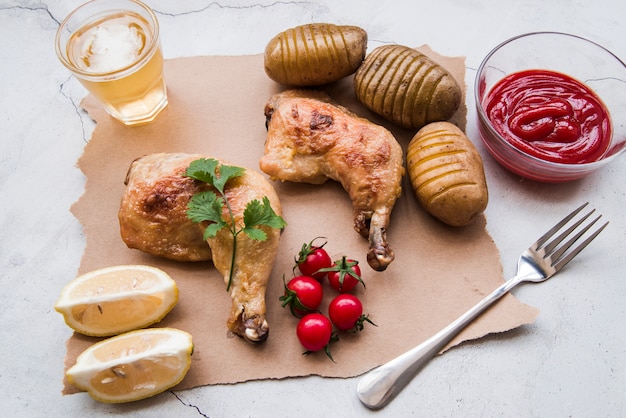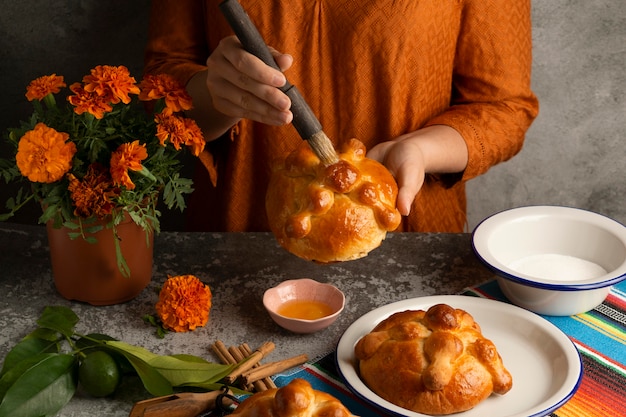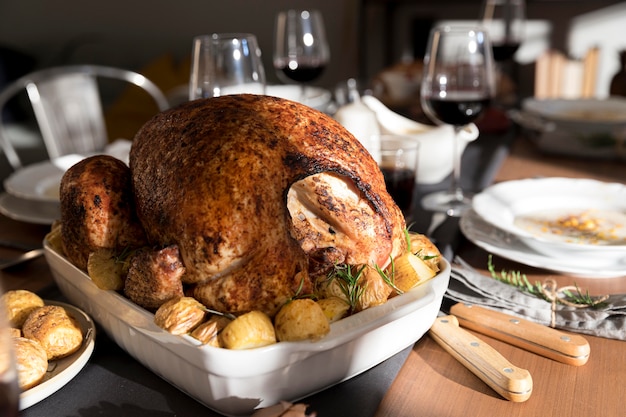(Part 1) Getting Started: Choosing Your Hen

We're kicking things off with the most crucial ingredient: the star of the show, the Cornish hen. Finding the right one is like finding the perfect partner for your dish – a match made in culinary heaven.
1. Size Matters
When it comes to Cornish hens, size matters. Aim for a hen weighing between 1 and 1.5 pounds. This is ideal for two people, and you can always adjust the recipe if you're serving a larger crowd. You can always get a couple of hens if you’re a bit uncertain – you know, just in case those seconds turn into thirds!
Remember the time I was hosting a potluck dinner and underestimated the appetite of my guests? We ended up devouring three Cornish hens, and the leftovers were snatched up in a flash! You never know what kind of culinary chaos you might create with a delicious cornish hen.
2. Look for the Plump Ones
A good Cornish hen should feel plump and firm to the touch. It should have a healthy weight to it, not feel thin or flimsy. You want that juicy, meaty goodness, not a lot of empty pockets of air.
Imagine biting into a hen that feels like a deflated balloon – not exactly the experience you're looking for, is it? We want a hen that's packed with flavor, not empty space.
3. Check the Colour
The skin should be a nice, pale yellow color. If it's looking a bit red or purple, it could be a sign that the hen hasn't been stored properly. And that's a big no-no.
I once bought a Cornish hen that had a strange, greyish hue. Turns out it had been left out at room temperature for too long. Needless to say, it ended up in the bin – a sad reminder that quality matters!
(Part 2) Preparing Your Hen for Roasting

Now that you've got your perfect hen, it's time to get it prepped for the oven. This is where the magic begins, transforming a simple Cornish hen into a culinary masterpiece. It’s all about getting that beautiful, crispy skin and succulent, juicy meat that’ll have everyone asking for seconds (and maybe even thirds!).
1. Giving the Hen a Good Wash
First things first, rinse your hen under cold running water. Make sure to get rid of any excess dirt or debris. You can give it a quick pat dry with paper towels, but don't worry about getting it bone dry – a little moisture helps with the roasting process.
2. The Art of Brining
This is a technique I learned from my grandmother, and it makes a HUGE difference. Brining your hen helps to lock in moisture and create a more succulent and flavorful result. It's like giving your hen a spa treatment before its big moment in the oven.
Here's how you do it:
- Mix together 1 cup of kosher salt and 1 cup of sugar in a large bowl. You can also add a few sprigs of fresh herbs like thyme or rosemary, if you like. It's like creating a little herb garden for your hen to enjoy while it's soaking.
- Add 4 cups of cold water and stir until the salt and sugar are fully dissolved. This creates a magical brine that will work its wonders on your hen.
- Place your hen in the brine, making sure it's fully submerged. Cover the bowl and refrigerate for at least 2 hours, and up to 6 hours. The longer you brine, the more flavorful your hen will be.
Don't be afraid to experiment with different brining solutions. Some people like to add a splash of white wine or apple cider vinegar for an extra layer of flavor. It's all about finding what works best for you and your taste buds.
3. Prepping for the Oven
Once your hen has been brined, pat it dry with paper towels. Then, give it a good rub with olive oil – it’s like a luxurious massage for your hen. Now, it’s time for the seasoning – the final touch that will transform your hen from ordinary to extraordinary. Season it liberally with salt and pepper. Feel free to add other spices like paprika, garlic powder, or cayenne pepper, depending on your taste.
You can stuff the hen with herbs and lemon wedges for extra flavour, or just roast it plain. The important thing is to create a nice layer of seasoning that will give the skin a delicious crunch. Think of it as a culinary hug for your hen before it goes into the oven.
(Part 3) The Big Roast

Now comes the moment of truth – the big roast. This is where your oven becomes your trusty sidekick, helping you create a masterpiece.
1. Preheat Your Oven
Preheat your oven to 400°F (200°C). This will ensure that your hen cooks evenly and gets that golden brown crust you're aiming for. The oven is the key to unlocking the full potential of your Cornish hen, transforming it into a symphony of flavors.
2. The Roasting Rack
Place your hen on a roasting rack set inside a baking sheet. This will help the heat circulate evenly around the hen, resulting in crispy skin all over. The roasting rack is like a throne for your hen, ensuring it receives the perfect amount of heat from every angle.
If you don't have a roasting rack, just place the hen directly on the baking sheet, but be prepared to turn it halfway through cooking to ensure even browning. A little extra effort goes a long way in achieving that perfect golden brown crust.
3. Timing is Everything
The roasting time will depend on the size of your hen. A 1-pound hen should take about 45-50 minutes, while a 1.5-pound hen will need closer to 55-60 minutes. The best way to know if it's done is to insert a meat thermometer into the thickest part of the thigh. It should register 165°F (74°C). If the thermometer isn't reading that temperature, keep it in the oven for another 5-10 minutes.
4. Basting for Extra Crispiness
For that extra crispy skin, you can baste your hen every 15-20 minutes with the pan drippings. Just use a spoon to scoop out the juices and drizzle them over the hen. This will help the skin brown beautifully and create a delicious, savory crust.
Think of it as showering your hen with a golden elixir, creating that irresistible crunch that’s both satisfying and flavorful. It’s a little bit of culinary magic that transforms the ordinary into extraordinary.
(Part 4) Letting the Hen Rest
Once your hen is cooked through, don’t rush to carve it up. Patience is a virtue in the kitchen. Give it a break, let it rest for about 10 minutes before serving. This allows the juices to redistribute throughout the meat, making it even more tender and flavorful.
1. Cover with Foil
Cover the hen loosely with aluminum foil while it rests. This will help to trap in the heat and steam, making sure it stays warm and juicy. Think of it as wrapping your hen in a warm, comforting blanket.
2. Resist the Urge to Carve
I know it's tempting to dig in right away, but trust me on this one. Patience is key! Waiting for the hen to rest will make all the difference in the end. It's a small sacrifice for a much greater reward – a juicy, flavorful, and unforgettable experience.
(Part 5) Serving Your Roasted Hen
Now it's time to reap the rewards of your culinary journey. It’s time to enjoy the fruits of your labor – a beautifully roasted Cornish hen, ready to be devoured.
1. The Carving Ceremony
Start by carefully carving the hen into serving pieces. You can use a sharp knife to separate the legs, thighs, and breasts. Make sure to carve along the bone to avoid tearing the meat. It’s a delicate dance of knife and meat, requiring a touch of finesse.
2. Sides Galore
Cornish hen goes beautifully with a variety of sides, like roasted vegetables, mashed potatoes, or a simple salad. Feel free to get creative and experiment with different combinations. It’s a blank canvas for your culinary creativity, allowing you to personalize the experience.
3. A Touch of Elegance
For a touch of elegance, you can serve your Cornish hen on a platter with a sprig of fresh herbs and a squeeze of lemon juice. Don't forget to offer your guests some gravy made from the pan drippings. It's the perfect finishing touch, adding a final layer of sophistication to your masterpiece.
(Part 6) Leftover Magic
Let's be honest, sometimes there are leftovers. But don't fret! You can easily transform those leftover Cornish hen pieces into a whole new meal. It's like a culinary transformation – turning leftovers into something new and exciting.
1. A Hearty Salad
Shred the leftover meat and toss it into a salad with mixed greens, tomatoes, cucumbers, and a vinaigrette dressing. It's a light and refreshing way to use up those leftovers. It’s a simple yet delicious way to add a touch of protein and flavor to your salad.
2. A Delicious Sandwich
Chop up the leftover hen and add it to a sandwich with your favorite toppings. It's a quick and easy lunch or dinner that's full of flavor. It’s a perfect way to satisfy those lunchtime cravings with a satisfying and flavorful sandwich.
3. A Warm and Cozy Soup
Use the leftover hen bones to make a flavorful broth. You can then add in leftover meat, vegetables, and noodles for a hearty and comforting soup. It's a wonderful way to transform those leftovers into a delicious and comforting bowl of soup.
(Part 7) Tips for perfect cornish hen Every Time
Here are a few extra tips I've learned over the years that will help you achieve perfect oven-roasted Cornish hen every time.
1. Don't Overcook It
A common mistake is overcooking the hen. It's important to cook it to the right temperature, but avoid drying it out. If you're unsure, check the internal temperature with a meat thermometer. It's like finding the sweet spot in your culinary journey – a delicate balance between tenderness and crispiness.
2. Give It Some Space
Don't overcrowd the baking sheet. If you're roasting multiple hens, give them some space to cook evenly. Each hen deserves its own space to breathe and reach its full potential.
3. Get Creative with Flavors
Experiment with different spices, herbs, and marinades. You can create endless flavor combinations to suit your taste. The culinary world is your oyster, allowing you to explore and create new and exciting flavor profiles.
(Part 8) FAQs
Now, let's answer some common questions about oven-roasted Cornish hen, clearing up any lingering doubts you might have.
1. Can I substitute chicken for Cornish hen?
You can definitely substitute chicken for Cornish hen, but it will need a longer roasting time. A whole chicken will take about 1.5 to 2 hours to cook. Keep an eye on the internal temperature to make sure it's fully cooked.
2. What can I do with the pan drippings?
The pan drippings are pure gold! You can use them to make a delicious gravy for your hen. Simply pour them into a saucepan, bring to a boil, and whisk in some cornstarch slurry to thicken it up. It's like transforming those drippings into a culinary masterpiece, adding a final touch of flavor and richness to your dish.
3. How can I tell if my hen is cooked through?
The best way to know for sure is to insert a meat thermometer into the thickest part of the thigh. It should register 165°F (74°C). You can also check if the juices run clear when you cut into the thigh. It’s a simple check that guarantees a perfectly cooked and safe dish.
4. How long can I keep cooked Cornish hen in the fridge?
Cooked Cornish hen can be stored in the fridge for up to 3-4 days. Make sure to store it in an airtight container to prevent it from drying out. It's a great way to plan ahead and enjoy a delicious meal even when you’re short on time.
5. Can I freeze Cornish hen?
Yes, you can freeze Cornish hen for up to 3 months. To freeze, wrap it tightly in plastic wrap and then place it in a freezer-safe bag. Thaw it in the refrigerator overnight before cooking. It's like putting your culinary creativity on hold, ready to be revived when you're ready to cook a delicious meal.
There you have it – my ultimate guide to oven-roasted Cornish hen. Remember, the key is to use fresh ingredients, season generously, and cook it to perfection. Enjoy the journey, embrace the process, and savor every bite of this culinary masterpiece!
Everyone is watching

Perfect Rice Every Time: The Ultimate Guide to Cooking Rice
Cooking TipsAs a self-proclaimed foodie, I've always been a bit obsessed with rice. It's the foundation of countless cuisi...

Prime Rib Roast Cooking Time Chart: Per Pound Guide
Cooking TipsPrime rib roast. Just the name conjures images of lavish dinners, crackling fires, and hearty laughter. It’s ...

The Ultimate Guide to Cooking Asparagus: Tips, Techniques, and Recipes
Cooking TipsAsparagus. The mere mention of this spring delicacy conjures up images of vibrant green spears, crisp and burs...

Ultimate Guide to Cooking the Perfect Thanksgiving Turkey
Cooking TipsThanksgiving. Just the word conjures up images of overflowing tables laden with delicious food, the scent of r...

How Long to Bake Potatoes in the Oven (Perfect Every Time)
Cooking TipsBaked potatoes are a staple in my kitchen. They're incredibly versatile, delicious, and surprisingly easy to m...
